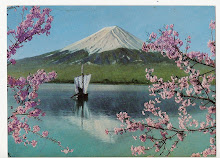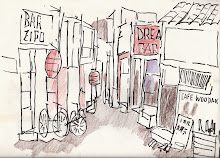THE YOKOHAMA PIER OF THE LATE 1800S. Photo by famous Japanese photographer of that era, Takagi
www.baxleystamps.com/litho/ta/1919110319b.shtml
YOKOHAMA PIER, Photos by Takagi
YOKOHAMA PICTURE SHOW

Shot with my Petri in Yokohama 1962
RICE FIELD IN JAPAN 1962

I took this with my PETRI in Kanagawa Prefecture
Thursday, August 25, 2011
takagi_famous_1919_15
Japanese-American camp, war emergency evacuation, [Tule Lake Relocation Center, Newell, Calif.] (LOC)
Japanese-American camp, war emergency evacuation, [Tule Lake Relocation Center, Newell, Calif.] (LOC), a photo by The Library of Congress on Flickr.
It was a shameful act and one that should not have happened. Certainly, so many years after the fact, it causes anger and despondency, two things that tell us we are still humans with conscience feelings about right and wrong.
No, it will not happen again.
Who is our enemy on the homeland today? There are many more than there were in the 1940s, and most are Americans, some elected and some appointed. What? you ask!
No, no proof or evidence, just observance of what is happening in my good old USA, in Washington and in the foreign service. But of course, this is my opinion.
I still have that right to have an opinion.
Wednesday, August 24, 2011
Mt Fuji 富士山 and Farm and Wood Gatherer
Mt Fuji 富士山 and Farm and Wood Gatherer
There is quite a bit of detail in the largest size picture. There are a couple of workers to be seen.
___________________________________
Mt Fuji 富士山 and Farm and Wood... by born1945
Japanese children 1957
Japanese children 1957
Photo provided by Milt Kessler asachitose.com/MiltsPhotoIndex.html
___________________________________
Japanese children 1957 by asachitose
___________________________________
I look at this photograph and see children whose parents must have suffered much through World War Two. My heart aches for that suffering. I am glad that Japan has such a forgiving heart; I am so glad we have been friends for more than 50 years.
__________________________________
My thanks to ASACHITOSE (Phil Peters) for making photos available for exhibition in BLOGABOUTJAPAN.
Monday, August 22, 2011
slide003
One of the best photographs I have seen of Mt Fuji with Yokohama in the foreground. I truly love this photograph.
___________________________________
Thanks to the photographer VINCENTVDS2
Sunday, August 21, 2011
HIKER SILHOUTTE
HIKER SILHOUTTE by i_love_japan_27
__________________________________
Photograph by Brad, a Flickr friend...
Saturday, August 20, 2011
Otorii (Gate) at Itsukushima Shrine, Japan
I love the lights in the distance. Lights twinkling in the distance are always special, but in Japan, such lights were joyful like no others. Perhaps, it was simply youth and Japan combined. Your photography is really special.
_________________________________
PHOTOGRAPHY BY SUE ANN SIMON
Wednesday, August 17, 2011
Ernst Ludwig Kirchner 'Mädchen unterm Japanschirm'
Ernst Ludwig Kirchner 'Mädchen unterm Japanschirm'
Quelle: HAZ, Ausgabe 15. Juli 2009.
___________________________________
Thanks to Pittigliani for exhibition of a masterpiece influence by the Japanese art of the era.
Sunday, August 14, 2011
Untitled
I have a title for this photo: One Mastepiece by Owen Finn. I could write a novel about such scenes, really.
Best Place to Write Novels
Yes. Once I get back to Japan, I hope to find a room like this to write the novel that lives in both my heart and mind.
Thanks to Yoshihiko Inui for a photographic masterpiece.
maiko od genka
...she sent me a photograph of herself in a kimono like this one and I was sorry that we had said "sayonara." That was in 1964.
THE BEACH VENDOR -- A Happy Snack of Japanese "Oden"
THE BEACH VENDOR -- A Happy Snack of Japanese "Oden"
Ca.1898 photograph by T. ENAMI of Yokohama. ODEN....Yummy ! What you are looking at here is the Japanese equivalent of a Hot Dog Stand along the boardwalk of Atlantic City or Coney Island. If native Japanese looked at this picture while hungry, they would probably start to drool. www.t-enami.org/
MOTOMACHI STREET SCENE 1962, By Robert L.Huffstutter
HISTORY OF MOTOMACHI, WIKIPEDIA REFEERNCES.......
Motomachi was originally a quiet farming and fishing village until 1859, when the Port of Yokohama was opened. Since then, the close-by Kannai district became the foreigners' business district, and the adjacent Yamate and Yamashitacho districts became the foreigners' residential districts. Situated in-between, with Yamate to the east, and Kannai and Yamashitacho to the west, Motomachi became frequented by many foreigners. Shops and businesses were opened, catering to the needs of foreigners.
Soon after the start of the Meiji era, the number of foreign residents increased. And western influence became more evident in Motomachi, with the opening of many cafés, bakeries, and boutiques. Such shops were uncommon in Japan at the time, and Motomachi helped introduce Western culture into Japan, as part of what is called bunmei kaika (文明開化?). This was the beginning of the Motomachi Shopping Street as it is known as of 2008.
In the 1970s, the "Motomachi Shopping Street" produced a new style of fashion called the hama tora (ハマトラ?) (short for "Yokohama traditional"). The most famous producers of the hama tora style were Kitamura [1], Mihama [2], and Fukuzō [3], three of the most fashionable boutiques in Motomachi.
In the 1960s, on one end of Motomachi stood the German Bakery and next door was the fantastic Madame Pompadour Bakery with the best puff pastry imaginable. When the aromas filled the street on Saturday mornings it was beyond description. On the end stood (and stands today) Nakayas grocery store, which sold wonderful liquor spiked communist jellies and jams from Czechoslovakia; nearby the vinyl record store which made available many popular 45 rpm records of the day on RCA Victor such as the Monkees and the Beatles. In between as today stands the Union Supermarket where one could purchase US or Japanese versions of the same cereals such as Sugar Pops. And across the street stood the French Restaurant with the best chocolate ice cream.
[edit] NamingUpon the opening of the Port of Yokohama in 1859, this area was called Motomura (本村?). The name was changed to Motomachi in 1860.
en.wikipedia.org/wiki/Motomachi,_Yokohama
Wednesday, August 10, 2011
MUSICAL JAPANESE AUTO VIDEO FROM THE 1960S
MUSICAL JAPANESE AUTO VIDEO FROM THE 1960S
A friend of mine who knows how much I love the Japan of the 60s sent me some really vintage film clips a while back. I have been selfish, keeping them for my enjoyment, so now is the time to share them with you who also like vintage Japan, and of course, Japan today too.
View and listen, and let me know what you think. It is all about Japanese autos and pretty young women, Tokyo and Yokohama in early 60s.
www.youtube.com/watch?v=3aGx5_0A7qc&feature=related
Friday, August 5, 2011
noge street
SUDDENLY, IT IS 1961 AGAIN! What is missing, however, is the crowd of young women and young men from different cultures, meeting and partying until the early light of dawn. Perhaps this party has moved to another area?
PHOTO BY MOLLY DES JARDIN
This looks like it is near Ise-Zaki-Cho in Yokohama.
READY FOR A MOTOMACHI WEEKEND IN YOKOHAMA
READY FOR A MOTOMACHI WEEKEND... by roberthuffstutter
__________________________________
TAKING A TRIP BACK TO THE 60S WHEN JAPAN WAS REBUILDING, WHEN JAPAN WAS BECOMING THE SUPER ECONOMY OF THE WORLD. I WAS THERE AND WATCHED WITH GREAT ADMIRATION AND FASCINATION.
This is a sketch of one of my favorite weekend getaways in Yokohama where I could blend with the city and paint from my window, listening to the sights and sound of this most unique nation.
Thursday, August 4, 2011
INSPIRED BY VAN GOGH
VIEW FROM MY APARTMENT IN JAPAN IN 1963. Inpspired by Van Gogh's style. I only wish that he had been able to have visited Japan. I can only imagine what he would have painted. He often mentioned Japanese art; he admired Japanese art and lifestyle. What artist doesn't?











